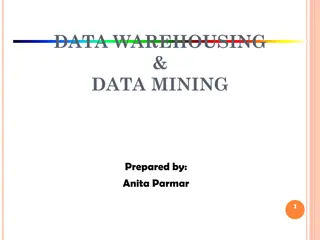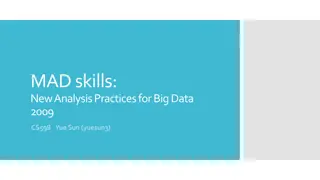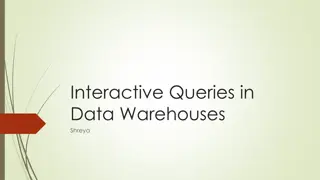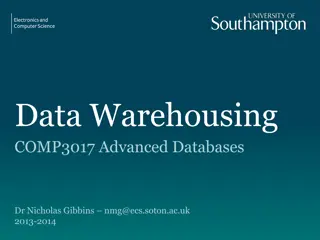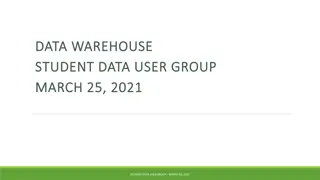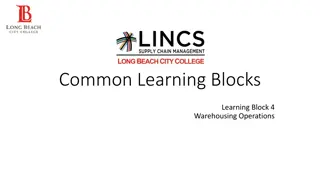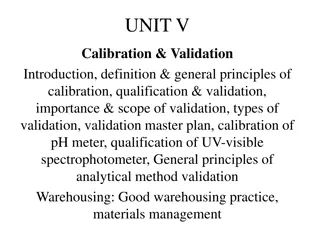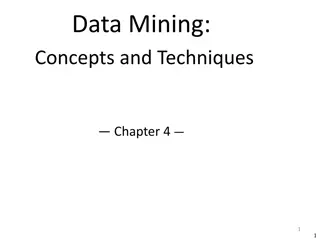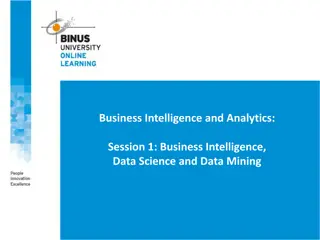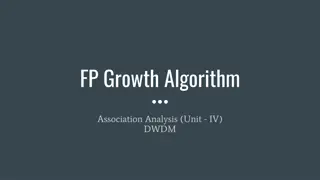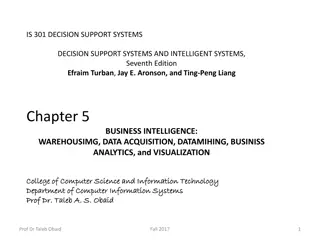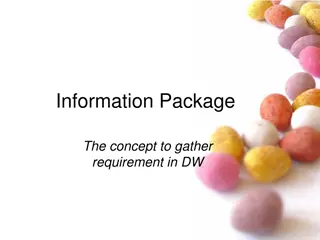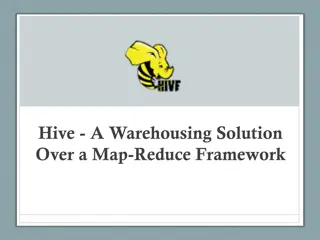Understanding Data Warehousing: Key Concepts and Characteristics
Data warehousing is a decision support database separate from operational databases, offering consolidated historical data for analysis. It is subject-oriented, integrated, time-variant, and nonvolatile, focusing on providing valuable insights for management decisions. Key features include subject-oriented organization, data integration, and a time horizon extending beyond operational systems.
Uploaded on Sep 16, 2024 | 0 Views
Download Presentation

Please find below an Image/Link to download the presentation.
The content on the website is provided AS IS for your information and personal use only. It may not be sold, licensed, or shared on other websites without obtaining consent from the author. Download presentation by click this link. If you encounter any issues during the download, it is possible that the publisher has removed the file from their server.
E N D
Presentation Transcript
Knowledge Data Discovery TOPIC 5 - Data Warehousing and Online Analytical Processing Antoni Wibowo
COURSE OUTLINE 1. WHAT IS A DATA WAREHOUSE? 2. A MULTI-DIMENSIONAL DATA MODEL 3. DATA WAREHOUSE ARCHITECTURE 4. FROM DATA WAREHOUSING TO DATA MINING
Note: This slides are based on the additional material provided with the textbook that we use: J. Han, M. Kamber and J. Pei, Data Mining: Concepts and Techniques and P. Tan, M. Steinbach, and V. Kumar "Introduction to Data Mining .
What is Data Warehouse? Defined in many different ways, but not rigorously. A decision support database that is maintained separately from the organization s operational database Support information processing by providing a solid platform of consolidated, historical data for analysis. A data warehouse is a subject-oriented, integrated, time-variant, and nonvolatile collection of data in support of management s decision-making process. W. H. Inmon Data warehousing: The process of constructing and using data warehouses Data Warehousing, Data Generalization, and Online Analytical Processing September 16, 2024 4
Data Warehouse Subject-Oriented Organized around major subjects, such as customer, product, sales Focusing on the modeling and analysis of data for decision makers, not on daily operations or transaction processing Provide a simple and concise view around particular subject issues by excluding data that are not useful in the decision support process Data Warehousing, Data Generalization, and Online Analytical Processing September 16, 2024 5
Data Warehouse Integrated Constructed by integrating multiple, heterogeneous data sources relational databases, flat files, on-line transaction records Data cleaning and data integration techniques are applied. Ensure consistency in naming conventions, encoding structures, attribute measures, etc. among different data sources E.g., Hotel price: currency, tax, breakfast covered, etc. When data is moved to the warehouse, it is converted. Data Warehousing, Data Generalization, and Online Analytical Processing September 16, 2024 6
Data Warehouse Time Variant The time horizon for the data warehouse is significantly longer than that of operational systems Operational database: current value data Data warehouse data: provide information from a historical perspective (e.g., past 5-10 years) Every key structure in the data warehouse Contains an element of time, explicitly or implicitly But the key of operational data may or may not contain time element Data Warehousing, Data Generalization, and Online Analytical Processing September 16, 2024 7
Data Warehouse Nonvolatile A physically separate store of data transformed from the operational environment Operational update of data does not occur in the data warehouse environment Does not require transaction processing, recovery, and concurrency control mechanisms Requires only two operations in data accessing: initial loading of data and access of data Data Warehousing, Data Generalization, and Online Analytical Processing September 16, 2024 8
Data Warehouse vs. Heterogeneous DBMS Data warehouse: update-driven, high performance Traditional heterogeneous DB integration: A query driven approach Information from heterogeneous sources is integrated in advance and stored in warehouses for direct query and analysis Build wrappers/mediators on top of heterogeneous databases A meta-dictionary is used to translate the query into queries and the results are integrated into a global answer set Complex information filtering, compete for resources Data Warehousing, Data Generalization, and Online Analytical Processing September 16, 2024 9
Data Warehouse vs. Heterogeneous DBMS OLTP (on-line transaction processing) Major task of traditional relational DBMS Day-to-day operations: purchasing, inventory, banking, manufacturing, payroll, registration, accounting, etc. OLAP (on-line analytical processing) Major task of data warehouse system Data analysis and decision making Distinct features (OLTP vs. OLAP): User and system orientation: customer vs. market Data contents: current, detailed vs. historical, consolidated Database design: ER + application vs. star + subject View: current, local vs. evolutionary, integrated Access patterns: update vs. read-only but complex queries Data Warehousing, Data Generalization, and Online Analytical Processing September 16, 2024 10
Why Separate Data Warehouse? High performance for both systems DBMS tuned for OLTP: access methods, indexing, concurrency control, recovery Warehouse tuned for OLAP: complex OLAP queries, multidimensional view, consolidation Different functions and different data: historical data: Decision support requires historical data which operational DBs do not typically maintain data consolidation: DS requires consolidation (aggregation, summarization) of data from heterogeneous sources data quality: different sources typically use inconsistent data representations, codes and formats which have to be reconciled Note: There are more and more systems which perform OLAP analysis directly on relational databases Data Warehousing, Data Generalization, and Online Analytical Processing September 16, 2024 11
From Tables and Spreadsheets to Data Cubes A data warehouse is based on a multidimensional data model which views data in the form of a data cube A data cube, such as sales, allows data to be modeled and viewed in multiple dimensions Dimension tables, such as item (item_name, brand, type), or time(day, week, month, quarter, year) Fact table contains measures (such as dollars_sold) and keys to each of the related dimension tables In data warehousing literature, an n-D base cube is called a base cuboid. The top most 0-D cuboid, which holds the highest-level of summarization, is called the apex cuboid. The lattice of cuboids forms a data cube. Data Warehousing, Data Generalization, and Online Analytical Processing September 16, 2024 12
Multidimensional Data Model Data Warehousing, Data Generalization, and Online Analytical Processing 9/16/2024 13
Multidimensional Data Model 2D view Data Warehousing, Data Generalization, and Online Analytical Processing 14 9/16/2024
Multidimensional Data Model 3D view 9/16/2024 15
Multidimensional Data Model 4D view Data Warehousing, Data Generalization, and Online Analytical Processing 9/16/2024 16
Cube: A Lattice of Cuboids Data Warehousing, Data Generalization, and Online Analytical Processing September 16, 2024 17
Conceptual Modeling of Data Warehouses Modeling data warehouses: dimensions & measures Star schema: A fact table in the middle connected to a set of dimension tables *) Snowflake schema: A refinement of star schema where some dimensional hierarchy is normalized into a set of smaller dimension tables, forming a shape similar to snowflake Fact constellations: Multiple fact tables share dimension tables, viewed as a collection of stars, therefore called galaxy schema or fact constellation Data Warehousing, Data Generalization, and Online Analytical Processing September 16, 2024 18
Example: Star Schema Data Warehousing, Data Generalization, and Online Analytical Processing September 16, 2024 19
Example: Snowflake Schema Data Warehousing, Data Generalization, and Online Analytical Processing September 16, 2024 20
Example: Fact Constellation Data Warehousing, Data Generalization, and Online Analytical Processing September 16, 2024 21
Measures of Data Cube: Three Categories Distributive: if the result derived by applying the function to n aggregate values is the same as that derived by applying the function on all the data without partitioning E.g., count(), sum(), min(), max() Algebraic: if it can be computed by an algebraic function with M arguments (where M is a bounded integer), each of which is obtained by applying a distributive aggregate function E.g., avg(), min_N(), standard_deviation() Holistic: if there is no constant bound on the storage size needed to describe a subaggregate. E.g., median(), mode(), rank() Data Warehousing, Data Generalization, and Online Analytical Processing September 16, 2024 22
A Concept Hierarchy: Dimension (location) Data Warehousing, Data Generalization, and Online Analytical Processing September 16, 2024 23
View of Warehouses & Hierarchies Data Warehousing, Data Generalization, and Online Analytical Processing September 16, 2024 24
View of Warehouses & Hierarchies Data Warehousing, Data Generalization, and Online Analytical Processing 9/16/2024 25
A Sample Data Cube Date sum 3Qtr 4Qtr Total annual sales of TV in U.S.A. 1Qtr 2Qtr TV U.S.A PC VCR Country sum Canada Mexico sum All, All, All Data Warehousing, Data Generalization, and Online Analytical Processing September 16, 2024 26
Browsing a Data Cube Visualization OLAP capabilities Interactive manipulation Data Warehousing, Data Generalization, and Online Analytical Processing September 16, 2024 27
Visualization Data Warehousing, Data Generalization, and Online Analytical Processing 9/16/2024 28
Typical OLAP Operations Roll up (drill-up): summarize data by climbing up hierarchy or by dimension reduction Drill down (roll down): reverse of roll-up from higher level summary to lower level summary or detailed data, or introducing new dimensions Slice and dice: project and select Pivot (rotate): reorient the cube, visualization, 3D to series of 2D planes Other operations drill across: involving (across) more than one fact table drill through: through the bottom level of the cube to its back-end relational tables (using SQL) Data Warehousing, Data Generalization, and Online Analytical Processing September 16, 2024 29
Roll Up 9/16/2024 30
Drill Down 9/16/2024 31
Slice 9/16/2024 32
Dice 9/16/2024 33
Pivot 9/16/2024 34
Design of Data Warehouse: A Business Analysis Framework Four views regarding the design of a data warehouse Top-down view allows selection of the relevant information necessary for the data warehouse Data source view exposes the information being captured, stored, and managed by operational systems Data warehouse view consists of fact tables and dimension tables Business query view sees the perspectives of data in the warehouse from the view of end-user Data Warehousing, Data Generalization, and Online Analytical Processing September 16, 2024 36
Data Warehouse Design Process Top-down, bottom-up approaches or a combination of both Top-down: Starts with overall design and planning (mature) - Inmon Bottom-up: Starts with experiments and prototypes (rapid) - Kimball From software engineering point of view Waterfall: structured and systematic analysis at each step before proceeding to the next Spiral: rapid generation of increasingly functional systems, short turn around time, quick turn around Typical data warehouse design process Choose a business process to model, e.g., orders, invoices, etc. Choose the grain (atomic level of data) of the business process Choose the dimensions that will apply to each fact table record Choose the measure that will populate each fact table record Data Warehousing, Data Generalization, and Online Analytical Processing September 16, 2024 37
Three Data Warehouse Models Enterprise warehouse collects all of the information about subjects spanning the entire organization Data Mart a subset of corporate-wide data that is of value to a specific groups of users. Its scope is confined to specific, selected groups, such as marketing data mart Independent vs. dependent (directly from warehouse) data mart Virtual warehouse A set of views over operational databases Only some of the possible summary views may be materialized Data Warehousing, Data Generalization, and Online Analytical Processing September 16, 2024 39
Data Warehouse Development: A Recommended Approach September 16, 2024 Data Mining: Concepts and Techniques 40
Data Warehouse Back- End Tools and Utilities & & Clean Refresh Data Warehousing, Data Generalization, and Online Analytical Processing September 16, 2024 41
Metadata Repository Meta data is the data defining warehouse objects. It stores: Description of the structure of the data warehouse schema, view, dimensions, hierarchies, derived data defn, data mart locations and contents Operational meta-data data lineage (history of migrated data and transformation path), currency of data (active, archived, or purged), monitoring information (warehouse usage statistics, error reports, audit trails) The algorithms used for summarization The mapping from operational environment to the data warehouse Data related to system performance warehouse schema, view and derived data definitions Business data business terms and definitions, ownership of data, charging policies Data Warehousing, Data Generalization, and Online Analytical Processing September 16, 2024 42
OLAP Server Architectures Relational OLAP (ROLAP) Use relational or extended-relational DBMS to store and manage warehouse data and OLAP middle ware Include optimization of DBMS backend, implementation of aggregation navigation logic, and additional tools and services Greater scalability Multidimensional OLAP (MOLAP) Sparse array-based multidimensional storage engine Fast indexing to pre-computed summarized data Hybrid OLAP (HOLAP) (e.g., Microsoft SQLServer) Flexibility, e.g., low level: relational, high-level: array Specialized SQL servers (e.g., Redbricks) Specialized support for SQL queries over star/snowflake schemas Data Warehousing, Data Generalization, and Online Analytical Processing September 16, 2024 43
ROLAP Datastore (Example) Data Warehousing, Data Generalization, and Online Analytical Processing 9/16/2024 44
Data Warehouse Usage Three kinds of data warehouse applications Information processing supports querying, basic statistical analysis, and reporting using crosstabs, tables, charts and graphs Analytical processing multidimensional analysis of data warehouse data supports basic OLAP operations, slice-dice, drilling, pivoting Data mining knowledge discovery from hidden patterns supports associations, constructing analytical models, performing classification and prediction, and presenting the mining results using visualization tools Data Warehousing, Data Generalization, and Online Analytical Processing September 16, 2024 45
OLAP & OLAM Why online analytical mining? High quality of data in data warehouses DW contains integrated, consistent, cleaned data Available information processing structure surrounding data warehouses ODBC, OLEDB, Web accessing, service facilities, reporting and OLAP tools OLAP-based exploratory data analysis Mining with drilling, dicing, pivoting, etc. On-line selection of data mining functions Integration and swapping of multiple mining functions, algorithms, and tasks Data Warehousing, Data Generalization, and Online Analytical Processing September 16, 2024 46
Integrated OLAM & OLAP Data Warehousing, Data Generalization, and Online Analytical Processing 9/16/2024 47
Summary A data warehouse is a subject-oriented, integrated, time-variant, and nonvolatile collection of data in support of management s decision-making process. A data warehouse is based on a multidimensional data model which views data in the form of a data cube Four views regarding the design of a data warehouse : Top-down view, Data source view, Data warehouse view and Business query view. OLAP Architecture : Relational OLAP (ROLAP) , Multidimensional OLAP (MOLAP) , Hybrid OLAP (HOLAP) (e.g., Microsoft SQLServer) and Specialized SQL servers (e.g., Redbricks) . 48 September 16, 2024 Introduction
References 1. Han, J., Kamber, M., & Pei, Y. (2006). Data Mining: Concepts and Technique . Edisi 3. Morgan Kaufman. San Francisco 2. Tan, P.N., Steinbach, M., & Kumar, V. (2006). Introduction to Data Mining . Addison-Wesley. Michigan 3. Witten, I. H., & Frank, E. (2005). Data Mining : Practical Machine Learning Tools and Techniques . Second edition. Morgan Kaufmann. San Francisco 9/16/2024 Introduction 49
Thank You Thank You



